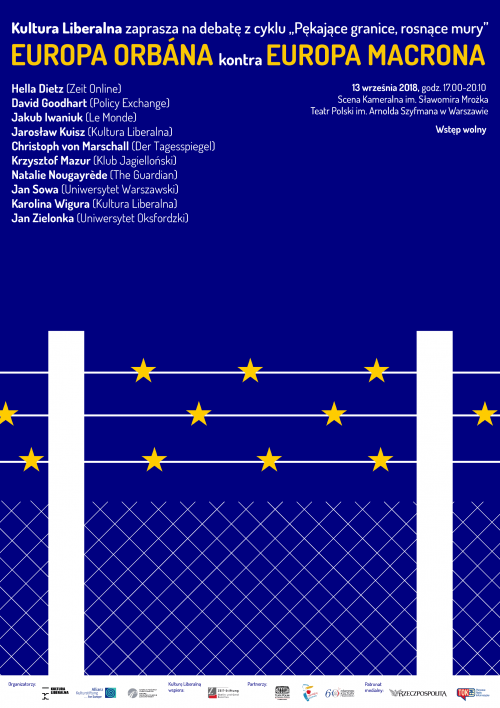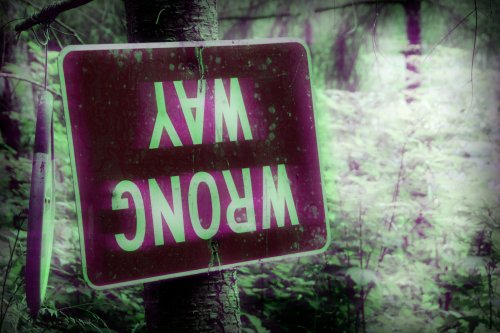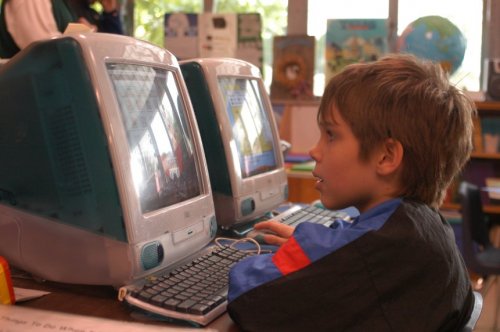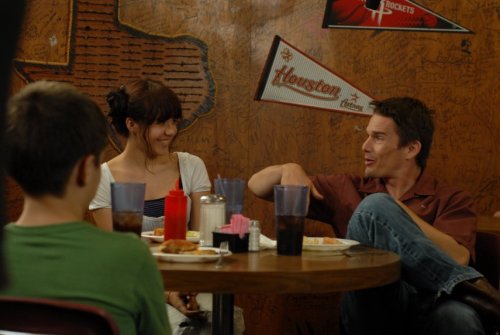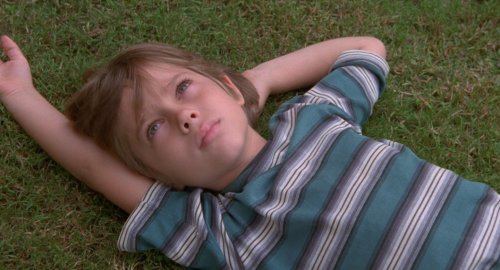Richard Linklater has got his viewers accustomed to bold cinematic experiments with long intervals between them. The trilogy Before Sunrise, filmed intermittently over 20 years, is an example not only of exceptionally patient determination of the director, but also of an open script-writing formula: the trajectories of Linklater’s characters meeting each other in successive stages of their life emerged from literary collaboration with actors playing them – Ethan Hawk and Julie Delpy.
Another unmistakable mark of Linklater’s directorial style is maintaining throughout all this period the ability to capture the fleeting nuances of interactions between the characters and to reflect in this way the nature of time, which usually escapes artists looking for a more poignant dramatic expression. The narrative of Dazed and Confused grew out of the experience of a long and monotonous cruising in search of adventure by a group of small-town teenagers. In Linklater’s style the emotional essence of a scene may be contained in a surreptitious exchange of glances – for example when Jesse and Celine are listening to music in the first part of the cycle. So Linklater is not only a specialist in long-range projects, but also a master of seizing elusive moments – or perhaps, as he says through the mouth of the protagonist of his newest project, a victim seized by these moments.
Linklater’s most recent project combines the best features of his craftsmanship. The film Boyhood had been made for 12 years, the fact which the director supposedly summarised during the premiere by saying that this was the true “12 years as a slave” feeling. Stretching the project over such a long time resulted in a film which is almost completely lacking in dramaturgy – the fabric of the story is a collection of fleeting moments brought together by the theme of the main protagonist and his sister (Ellar Coltrane and Lorelei Linklater) growing up and the ageing of their divorced parents (Ethan Hawke and Patricia Arquette). We meet the main character, Mason, as a dreamy six-year-old when his family is moving to Houston, and we say goodbye to him as a fresh high school graduate right after his arrival to the college campus. Despite the innovative character of the production, Linklater’s film may be considered as marked by classic features of a Bildungsroman, a formation story. What can we learn about the ”millennials” generation from invoking a genre with sources dating back to the 18th century?
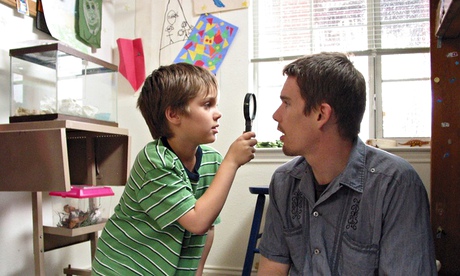
In search of the growing-up time
Predecessors of the Boyhood project should be thought above all in documentary cinema, where filmmakers have often employed their own to register the key moments of the growing-up period. Apart from Wszystko się może zdarzyć by Marcel Łoziński we could mention here the bold experiment by Viktor Kossakowski, whose protagonist is the director’s two-year-old son exposed for the first time to the image of his own reflection (the director had taken care to remove all reflexive surfaces from his view beforehand). The record of his reaction (Svyato, 2005) could well serve as an illustration of the emotions involved in the mirror stage as described by Jacques Lacan and others – integrating your own personality as a result of the first contact with the reflection of your body.
A prime example of a documentary observation of the growing up period stretched over time is the project Anna: 6 – 18 (1994) by Nikita Mikhalkov, who decided to patiently follow the growth of his own daughter, annually subjecting her to the same set of questions: What did she desire? What did she fear most? What did she hate most? This experiment, started in 1980 – when Anna was learning her first letters and was afraid only of crocodiles – is also an example of the director’s amazing intuition: the unexpected secondary (or perhaps main) theme of the story becomes the breakup of the Soviet empire and hence also of the hopes connected with the Soviet project of educating a new man.
But a similar long-time observation in fiction films – the entire genre of coming-of-age pictures notwithstanding – has been very rare. There were some rumours about Stanley Kubrick planning to involve the young Al Pacino in a long term follow-up project connected with an epic about Napoleon, which ultimately did not come into fruition. As Linklater himself noted in an interview, at the end of his own project he was not surprised that other directors were cautious in taking such commitments upon themselves: seeing the project to the end required a major producing effort and confidence in the lead actors (especially the observed protagonist). The successive stages of the film were made during annual three days of shooting, which resembled family reunions and resulted in 10-15 minutes of footage each. But such a mode of work, stretched over 12 years, turned out to favour the flexibility of the screenplay and adapting it to unpredictable cultural changes. This can be seen, for example, in the inclusion of the episode of the feverish anticipation of a midnight sale of the newest part of Harry Potter, preserving Mason’s painted nails as an expression of his fascination with the emo fashion or updating the soundtrack in line with the changing tastes of the growing protagonists.
Linklater admitted to taking inspiration from his personal experiences when working on the script, such as his parents’ separation, childhood spent with sisters, being raised by his mother trying to reconcile it with academic career. He could not resist engaging his own daughter as the actress portraying Mason’s sister, and later he drew Ellan Coltrane in working on the screenplay – the episode of his conversation with a girl met at a party is based on a real-life meeting which Linklater asked him to record. They also agreed that Coltrane would report to him the details of his appearance, down to every new earring. It is not surprising then that moved by fears of excessive self-consciousness of the lead actors, Linklater allowed them to see the work only when it was completed.
Such a tireless and painstaking way of implementing the project turned out to be the best instrument for reflecting the fluidity of the growing-up process. In contrast to Kossakowski’s method, Linklater did not focus on the supposed crucial moments of adolescence. Unlike in Mikhalkov’s story, the narrative is not built through careful recreating the evolution of Mason’s views under the impact of the surrounding political context. The fabric of the story consists of a set of minor observations, recorded without a previously intended dramatic power. The successive stages of Mason’s growing-up is a collection of moody moments, the significance of which can be assessed only on the basis of a close review of the story of our own growing up – like in the case of the memory about puncturing his schoolmates gum bubble with his finger, secret browsing of prohibited magazines with his friends, stealing into his house on return from a binge or his stepfather first blustering with masculine pride and then missing his golf shot.
So we will not find here a decisive rite of passage moment – unless we classify as such the sentimental family reunion of all characters at Mason’s high school graduation party. The political context of the story is barely sketched and seems to have no impact on the development of the protagonist – it only gets through to him as a wartime memory from Iraq of yet another stepfather or as an episode of his involvement in the first election campaign of Barack Obama. And yet the focus on the emotional development of the protagonist may be associated with the political revolution which was behind the birth of the literary genre of Bildugnsroman – a revolution which led to the emergence of liberal democracy.
Bildungsroman indie style
As noted by Thomas Jeffers in his work Apprenticeships. The Bildungsroman from Goethe to Santayana, the genre of “formation novel” not accidentally came into being in the second half of the 18th century, with the advent of modernity. In parallel to the social revolution engendered by the emancipating third estate, taking shape was a narrative intended at giving the descendants of the bourgeoisie a self-development model previously reserved for the aristocracy. Its foundations can be seen in the pedagogical doctrines of Jean-Jacques Rousseau and Friedrich Schiller, and its classic examples in Wilhelm Meister’s Journeyman Years by Goethe, Sons and Lovers by D.H. Lawrence or David Copperfield by Dickens. In Boyhood you can discern a set of standard motifs from the formation novel: developing emotional relations with parents, building peer bonds or struggling with finding your vocation –Goethe’s novel was intended as the first exponent of abandoning the nostalgia for versatility by the middle-class and coming to terms with the need to find fulfilment in one particular vocational role.
The sources of the historical process of the growing interest in formation novel could be extended onto the context explored by Philipp Aries in his History of childhood. According to the author, as late as in the 16th century children, regarded as “little adults” then, were not offered any special system of educational institutions aimed at helping them to adapt to mature live. The age of seven – when Mason’s story begins – marked the coming of age, with all the attendant burdens. The emergence of the oppressive regime of educational institutions, the system of punishments and boarding schools, paradoxically coincided with the increasingly “obsessive love of children which in the 18th century seized the society” [1]. Another expression of the new status of children was providing them with a private space in the layout of the house – not accidentally the argument which persuades Mason and his sister to agree to moving homes is their mother’s promise that they would get their own rooms. Charles Taylor perceives these processes as elements of the wider context of “valorisation of everyday life “, which was to become a feature of the modern moral attitude, also based on individualisation and an increasing focus on inner experience. On the eve of modernity the family ceases to be perceived as an immutable, patriarchal institution; instead it becomes a result of free choice of its members, conditioned by their emotional engagement [2]. Perceiving family ties as a kind of contract means also being prepared for their breakup – which also marks the successive relationships in which Mason’s mother is involved.
But Linklater’s story is far from portraying individual growing pains in the shadow of totalitarian educational institutions and the demons which these institutions may bring out in seemingly innocent adolescents. The young Mason does not experience temptations and confusions on the scale of those which affected young Torless described by Robert Musil, raised in a convent. The path followed by Linklater’s protagonist is not determined by any systematic, institutional patterns: for example, his passion for photography is not inspired by a standard lecture on the subject, but by his teacher’s words uttered casually in a darkroom. Mason is subjected to a number of disparate experiences, which do not seem as intended to impose on him a particular emotional pattern or social role. Paradoxically, the most exemplary model of education is implemented by a minor character – a young Mexican “brought on the right path” by Mason’s mother, who praises his intelligence and tells him to go to school when he is working in her garden. So what kind of education is sought by Mason, removed from the model institutional patterns of schooling?
Manhood as a brink of failure
According to Jeffers a Bildungsroman is a narrative which usually confronts the reader with the crisis of another institution: the traditional family model. A characteristic theme of the formation novel is challenging the status of the father or stepfather of the protagonist, evidenced, for example, in David Copperfield. Jeffers says that this theme is an echo of the modern rejection of the theistic outlook, the centre of which was the figure of God the Father, and with the traditional model of socialisation by a representative of the same sex [3]. Hence, the characters of a Bildungsroman usually have much stronger relationships with their mothers. The young protagonists – just like the bourgeoisie breaking up with religious patterns and emancipating itself through revolution – are not sure if their development will consist in simply recreating some existing roles; they must forge them themselves. Only sometimes – as in Goethe’s and Dickens’s novels – they encounter figures which turn out to be envoys of Providence and its secret plan. But in the 20th-century novel this motive is difficult to find.
So Linklater’s character is not accidentally struggling with various imperfect models of masculinity. Successive stepfathers, despite appearances of being stable, turn out to be deeply frustrated: a respectable academic soon reveals his real face of an alcoholic and despot, and an emotionally confused veteran of the Iraq war is vainly trying to build his authority in Mason’s eyes on the basis of the military discipline model. Instead there is a growing fringe group of representatives of disparate models of masculinity, offered by the photography teacher in school or the frail boss in a lousy job at the kitchen sink in a restaurant; and in one conversation Obi-Wan Kenobi is invoked as a good model for driving a car. During his first weekend meeting with his children, Mason’s biological father is confronted with his daughter’s charge that the only memory he has left are quarrels with their mother preceding their divorce. Pressed in this way, the character played by Ethan Hawke immediately counters: besides the memories of the conflict did she not preserve in her memory the family trip in the period when all was going well?
Paradoxically, in Linklater’s version the formation story about a missing father turns into a story about his return. The figure played by Ethan Hawke undergoes his own revolution – from a rocker experiencing a Sturm und Drang period in Alaska to an exemplary weekend father attempting to compensate his absence by provoking intensive, common family experiences. And there is no accident in the fact that he ultimately turns into a respectable member of the community of evangelical Christians – this is an instructive gesture in the context of the religious interpretation of the father figure and Jeffers’s work. The figure played by Hawke is in some respects a complete antithesis to the oppressive father presented in a coming-of-age story of another Texan – The Tree of Life by Terrence Malick. Its authoritarian protagonist played by Brad Pitt, trying to preserve the patriarchal family model, is unable to save his family from trauma and ultimately from emotional breakdown: the only hope for its unification is brought by a vision of afterlife [4]. In Linklater’s version it is the patchwork family model which turns out to be a fully functional environment for development – despite many crises its members are able to regain their sense of balance. This model also provides the protagonist with the most valuable lesson – the ability, instilled in him by his father, to draw the very best from the irrevocably fleeing time. And it is not a lesson of re-enchanting reality, such as was given by Roberto Benigni in Life is Beautiful or Giuseppe Tornatore in Cinema Paradiso. The figure played by Ethan Hawke walks with his feet firmly on the ground and this is what he wants to teach his son – he dispels the boy’s hopes for the existence of elves and instead he teaches him self-confidence (also as the fundamental method for getting the girls). Perhaps driven by his own sense of the lost years, he could be said to repeat the advice which he formulated during the first on-screen meeting with his son – life will not be lenient, but it is still marked by an undeniable beauty.
And this ability seems to be the primary lesson carried over by Linklater’s character into adult life. It is also an ability which in the scene of striking out for the campus he in a sense tries to teach his own mother, when she proves incapable of shedding her nostalgic attachment to the first photograph made by him. The main aim of Mason’s wanderings is not implementing a particular model of growing up but facing the challenge of time elapsing. While in the opening scene, when Mason as a child is staring at the sky, he represents the “seizing of fleeting moments” philosophy, at the end of his journey to maturity he seems closer to allowing that moments seize him. It would be probably difficult to find a better stand in for Linklater himself and his cinematic philosophy of time.
Notes:
[1] Philippe Ariès, Historia dzieciństwa, Dziecko i rodzina w dawnych czasach, Wydawnictwo Marabut, Gdańsk 1997, p. 237.
[2] Charles Taylor, Źródła podmiotowości. Narodziny tożsamości nowoczesnej, Wydawnictwo Naukowe PWN, Warszawa 2012, p. 542.
[3] Thomas L. Jeffers, Apprenticeships. The Bildungsroman from Goethe to Santayana, Palgrave MacMillan, New York 2005, p. 188.
[4] According to Philippe Ariès the transformation of the status of childhood was accompanied by a parallel change of the images of afterlife – they started to be modelled on a vision of undisturbed family harmony.
Film:
Boyhood, directed by Richard Linklater, USA 2014.


